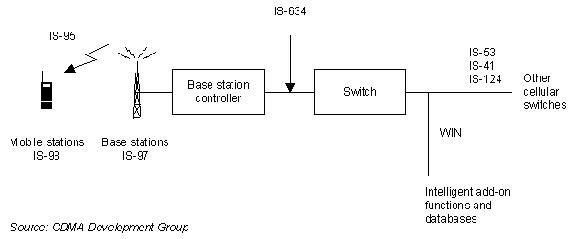Mobile Wireless Communications Today (cont.)
by Puneet
Gupta
Code Division Multiple Access (CDMA) Technology (IS-95)
(cdmaOne)
The CDMA technology used in North America is based on the
IS-95 protocol standard first developed by QUALCOMM. CDMA
differs from the other two technologies by its use of spread
spectrum techniques for transmitting voice or data over the
air. Rather than dividing RF spectrum into separate user
channels by frequency slices or time slots, spread spectrum
technology separates users by assigning them digital codes
within the same broad spectrum. Advantages of CDMA technology
include high user capacity and immunity from interference by
other signals. Like TDMA IS-136, CDMA operates in the 1900-MHz
band as well as the 800 band.
Work on developing the CDMA standard is conducted mainly by
the CDMA Development Group (CDG), a consortium of the main
CDMA manufacturers and operators formed to standardize and
promote CDMA technology. Whilst work to develop CDMA as a
third-generation technology has attracted a great deal of
attention over recent months, the CDG has also been working to
improve the current performance of CDMA as a second-generation
technology. The CDMA Development Group (CDG) has formally
adopted the cdmaOne name and logo as a technology designator
for all IS-95-based CDMA systems. The term represents the
end-to-end wireless system and the necessary specifications
that govern its operation. cdmaOne incorporates the IS-95 CDMA
air interface, the ANSI-41 network standard for switch
interconnection and many other standards that make up a
complete wireless system.

The CDMA technology, used in the Interim Standard IS-95,
maximizes spectrum efficiency and enables more calls to be
carried over a single 1.25 MHz channel. In a CDMA system each
digitized voice is assigned a binary sequence that directs the
proper response signal to the corresponding user. The receiver
demodulates the signal using the appropriate code. The
resulting audio signal will contain only the intended
conversation, eliminating any background noise. This allows
more calls to occupy the same space in the communication
channel, thereby increasing capacity. As a simple, example let
us assume a user is talking into a mobile phone on a CDMA
network. The transmitted portion of a voice signal has
frequency components from approximately 300~3400 Hz. This
analog signal is digitally encoded, using QPSK (Quadrature
Phase Shift Keying), at 9600 bps. The signal is then spread to
approximately 1.23 Mbps using special codes that add
redundancy. Some of these codes include a device ID that is
unique to the phone (like a serial number). Next the signal is
broadcast over the channel. When broadcast, the signal is
added to the signals of the other users in the channel. On the
receiving end, the same code is used to decode the incoming
signal. The 9600 bps signal is obtained and the original
analog signal is reconstructed. When the same code is used on
another user's signal, the redundancy is not removed and the
signal remains at 1.23 Mbps.
The problems are the quality of reception and voice
squeakiness. To address this major PCS carriers are using 13
kbps vocoders instead of 10 kbps. This improves quality but at
the cost of capacity. The technology has been widely adopted
by major cellular and PCS carriers in the United States and
also internationally. CDMA networks provide operators with
reliable digital systems that offer higher capacity, large
coverage area and improved voice quality and above all a good
3G upgrade path, CDMA 2000 (I'll discuss this later). It also
offers simplified system planning -- through the use of the
same frequency in every sector of every cell.
Factors contributing to CDMA's capacity gains are:
- Frequency reuse
- Soft handoffs
- Power control,
- Variable rate vocoders
Some of the benefits of using cdmaOne are:
- Capacity gains of eight to ten times that of AMPS analog
systems
- Improved call quality, with better and more consistent
sound as compared to AMPS systems
- Simplified system planning through the use of the same
frequency in every sector of every cell
- Enhanced privacy through the spreading of voice signals
- Improved coverage characteristics, allowing for fewer
cell sites
- Increased talk-time for portables
cdmaOne technology improves quality of service through the
use of soft handoffs, which greatly reduce the number of
dropped calls and ensure a smooth transition between cells. In
soft handoff, a connection is made to the new cell while
maintaining the connection with the original cell. This
transition between cells is one that is almost undetectable to
the subscriber. cdmaOne technology also takes advantage of
multipath fading to enhance communications and voice quality.
Using a rake receiver and other improved signal-processing
techniques, each mobile station selects the three strongest
multipath signals and coherently combines them to produce an
enhanced signal.
The cdmaOne data capabilities are based on IS-95A, which
can provide data speeds of 14.4kbit/s. IS-95B and IS-95C are
designed to enhance CDMA's data capability. IS-95B can provide
data speeds of up to 64kbit/s by aggregating existing
channels. IS 95-B can provide these enhanced data rates
through software upgrades only. IS-95C aims to offer a minimum
of 24.4kbit/s per channel and aggregated data speeds of more
than 115kbit/s. It is expected that IS-95C will define CDMA's
capability as a third-generation system. CDMA already supports
asynchronous data and faxing (IS-99) and has standardized
packet data (IS-657).
The major development initiatives being taken by the CDG
for 2G CDMA systems enhancements include Enhanced roaming
enables transparent roaming across cellular and PCS networks,
with selection of networks and location services. Enhanced
roaming will provide roaming between CDMA systems similar to
that on GSM: registration, authentication and credit-checking
are automatically carried out between the networks without
users having to do anything more than switch on their mobiles.
Roaming agreements will still be needed between operators.
Next:
Mobile Wireless Market: Technology Forecasts
| 
